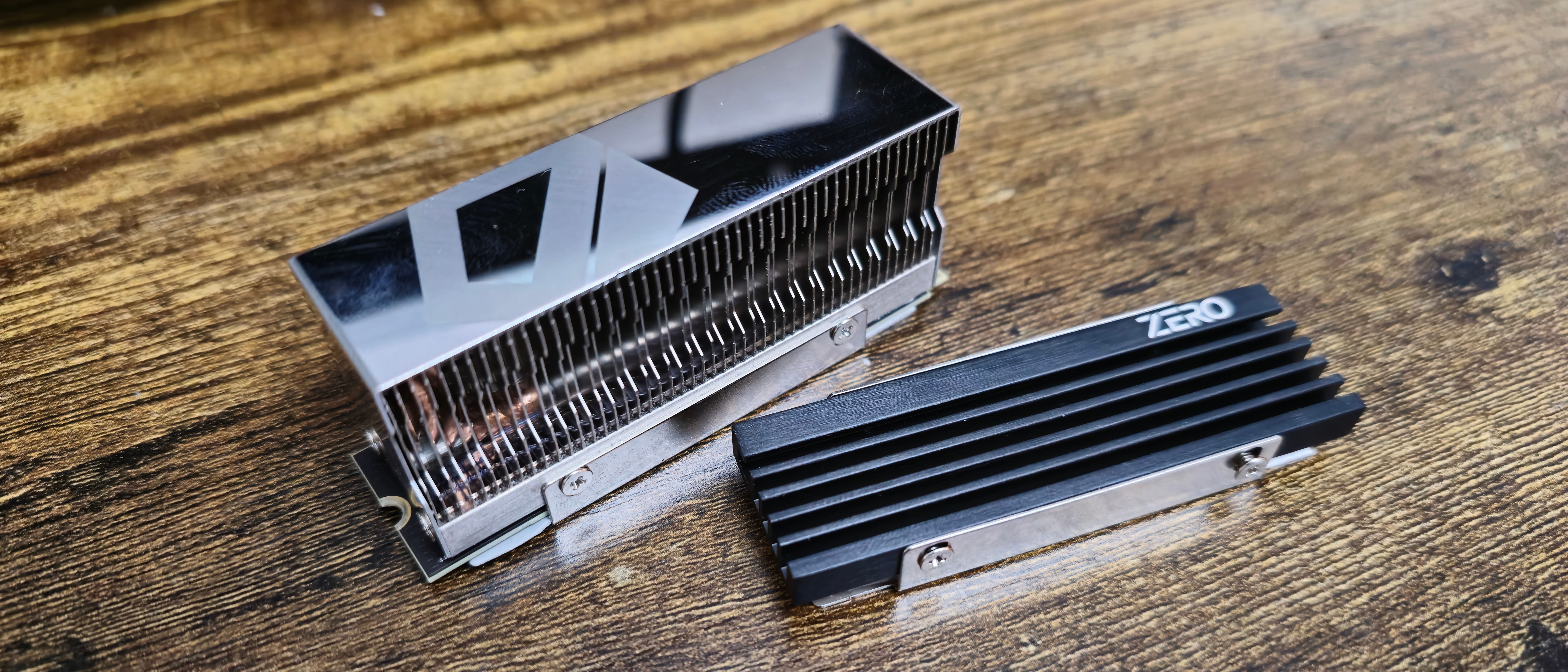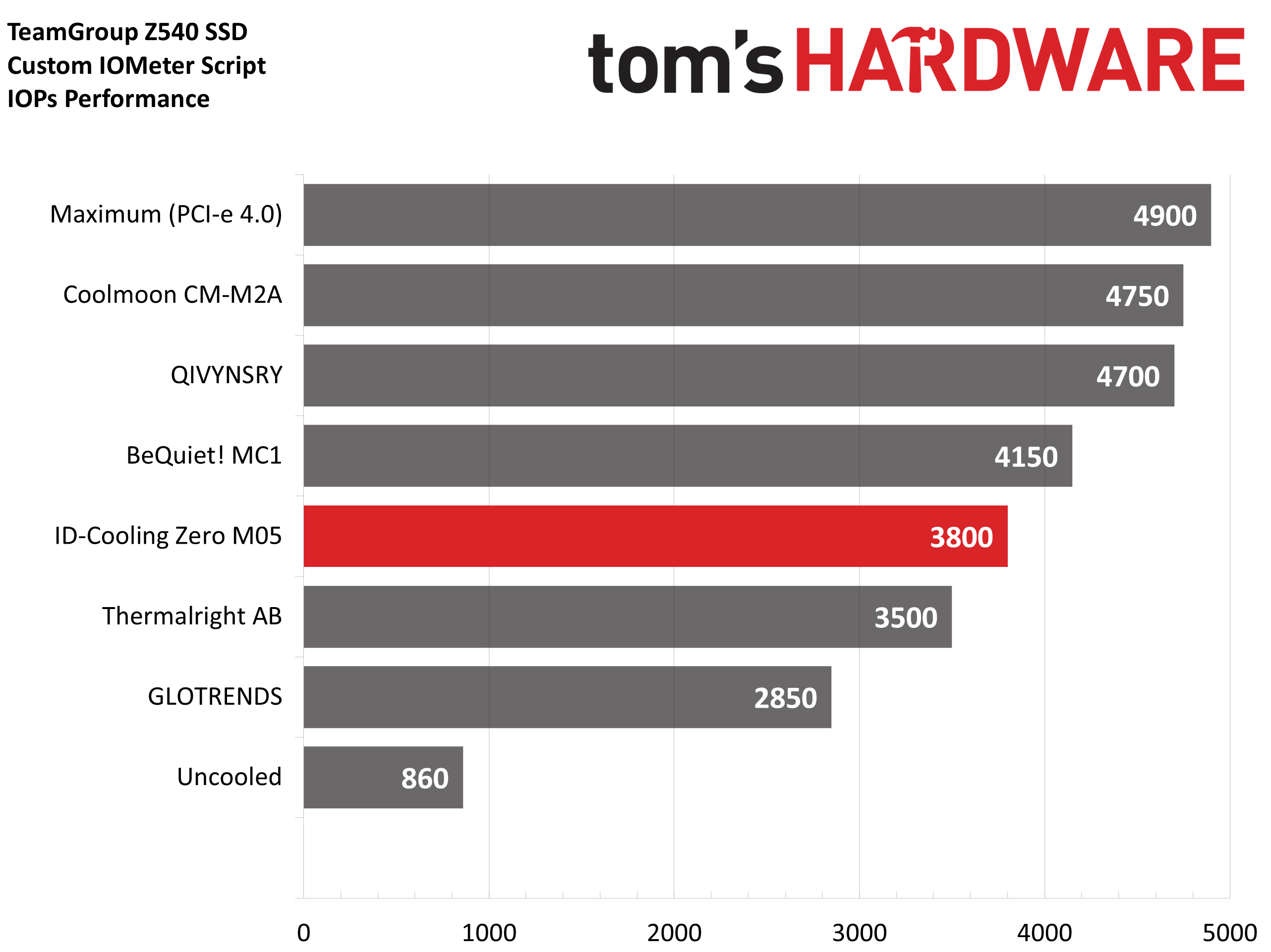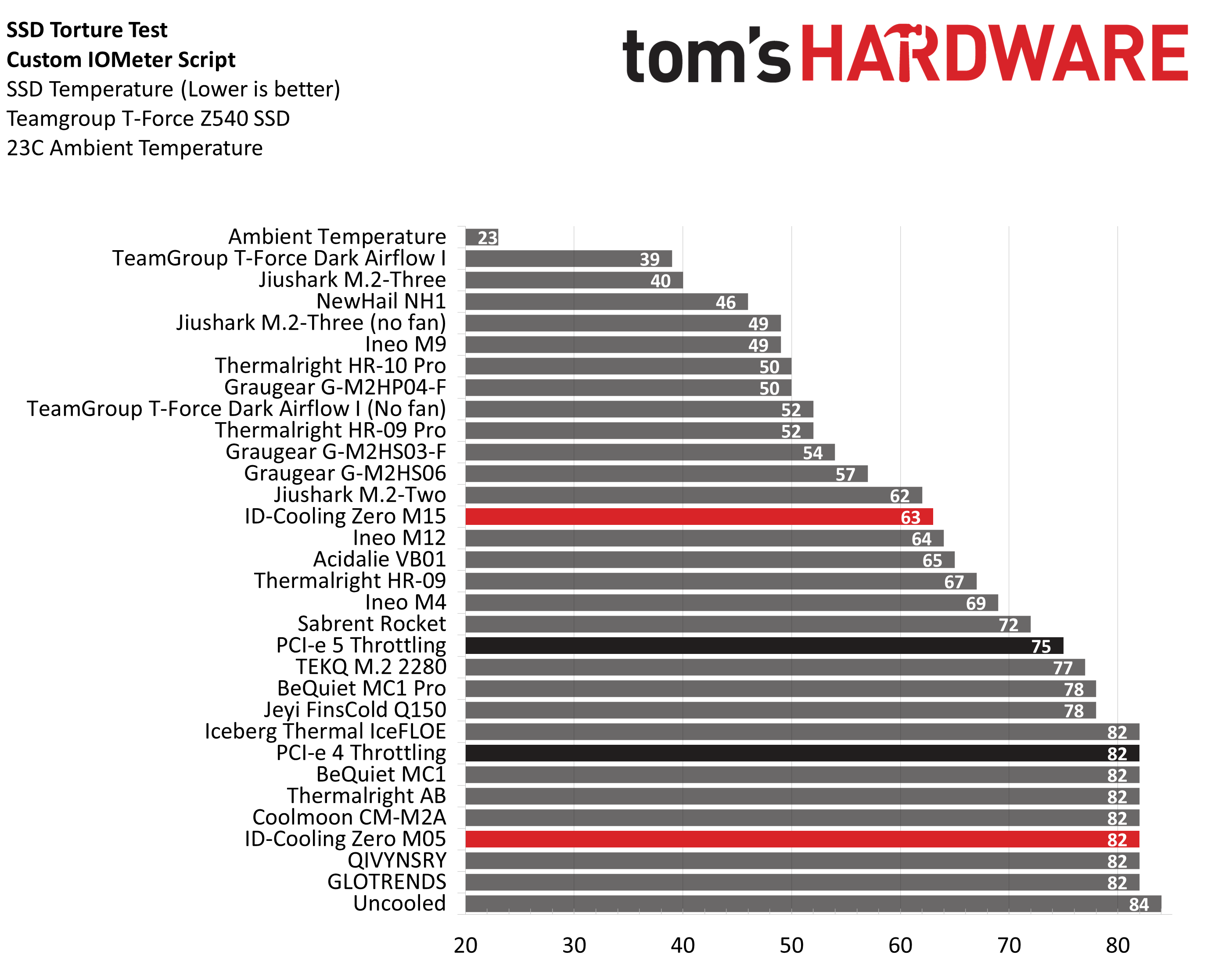Why you can trust Tom's Hardware
Thermal Results
The M05 is more of a basic heatsink. It reaches peak temperature and throttles during my stress tests. It achieves 3800 IOPs in this benchmark, about 77% of this drive’s maximum PCIe 4 performance. This means that the M05 will be sufficient for basic use, such as loading applications and games. But I wouldn’t recommend it for power users or anyone running storage-intensive workloads.
ID-Cooling’s more advanced M15 performed very well during these stress tests, never reaching beyond 63C. This is what I would consider a good result, but it is even more impressive when you consider that the M15 is only $10 – about half the price of competing units like the Acidalie VB01.
You’ll notice the graph above has two black bars indicating where PCIe 4 and PCIe 5 drives would throttle in these tests. My tests of these heatsinks are performed on a system that only supports PCIe 4, but I’ve also tested a variety of these heatsinks in a PCIe 5 system to see what differences might result. I’ve found that heatsinks will run up to 7C higher on PCIe 5. NAND will throttle at 82C, so any heatsink that reaches 75C or higher on my PCIe 4 test system will reach peak temperatures in a PCIe 5 system.
In general, even the worst of these heatsinks will be sufficient for common users - except perhaps the Glotrends unit I tested, which performed extremely poorly.
I consider heatsinks that are capable of keeping the SSD between 60-70C ideal and what most users looking for SSD cooling should purchase. Stronger SSD coolers and heatsinks that keep temperatures below 60C are essentially overkill, and should only be considered by users with extremely storage-intensive workloads.
Conclusion
At only $5 and $10 USD, both the M05 and M15 SSD heatsinks from ID-Cooling provide good value. I would recommend the M05 for mainstream users who engage in common workloads like loading applications and games. For professionals with storage-heavy workloads, you’ll want the stronger M15 unit instead.
The M15 is particularly appealing compared to its competition like Acidalie’s VB01 or Sabrent’s Rocket, which have price tags two to three times as expensive. It’s good to know that an SSD cooler is one area where you don’t have to spend a lot of money to get good results.
Get Tom's Hardware's best news and in-depth reviews, straight to your inbox.

Albert Thomas is a contributor for Tom’s Hardware, primarily covering CPU cooling reviews.
-
PlutoDelic Around a year ago, TeamGroup was mocking around with that AIO 120mm for SSD's. While niche in itself, i still think it's a wonderful idea to have that AIO there instead of as Exhaust fan.Reply
The moment one comes around with a 140mm rad, i'm jumping ship to PCIe Gen5. But with the current stand, PCIe Gen4 is more than enough. -
HideOut We tested 30 m.2 SSD heatsinks to find the top performer: ID-Cooling Zero M05 and M15 ReviewWe’ve tested 27 M.2 NVMe heatsinks to see how well they perform and what is best for your SSD’s peak performance.So which is it, 30 or 27?Reply -
Notton Does the Teamgroup Z540 have an even top level between its NAND, DDR, and controller?Reply
Some people recommend using two or more pads when the heights are uneven.
I used thick backside thermal pads on dual-sided SSDs, because there's usually a void with sparse SMD resistors under the controller and RAM. I figure the heatsink would need some pressure applied to the backside of the PCB, and not the SMDs to make proper contact with the controller. -
Albert.Thomas Reply
I should have that one for testing soon!PlutoDelic said:Around a year ago, TeamGroup was mocking around with that AIO 120mm for SSD's. While niche in itself, i still think it's a wonderful idea to have that AIO there instead of as Exhaust fan.
:oops:HideOut said:
We tested 30 m.2 SSD heatsinks to find the top performer: ID-Cooling Zero M05 and M15 ReviewWe’ve tested 27 M.2 NVMe heatsinks to see how well they perform and what is best for your SSD’s peak performance.So which is it, 30 or 27? -
thestryker Glad to see your M.2 heatsink testing land here at Tom's and with some additions!Reply
I wish the M05 had been out when I was getting mine as the best thing in the size was Thermalright's TR, but those don't really have fins. Fortunately they're good enough, but these would certainly have been a better choice.
The Team Group AIO seems like extreme overkill so I look forward to the ridiculousness. -
Amdlova You can place thermal pads on the back touching the motherboard :) droop the temps a lot :)Reply -
Albert.Thomas I've realized from some of the comments on other places that I need to explain my testing methodology in a bit more detail.Reply
1) Testing is comprised of 3x 30 minute runs. The first test is a burn in test. The 2nd test is the primary testing run, and the third test is for verification. Thus far, the results of tests 2 and 3 have always been the same. However, if that ever occurs another round of testing will happen.
2) I use a 360mm AIO during testing, as the airflow of a CPU cooler will impact results. However, there's a good argument to made that an air cooler should be used with these lower end heatsinks. In the future I plan to test a few of them with an air cooler to investigate how much it improves their performance. -
mac_angel umm, not sure if I missed it. A lot of motherboards have their own heatsinks for m.2 drives now. While they aren't going to be as great as the M15, how do they measure up to nothing at all?Reply -
Albert.Thomas Reply
You bring up a good point. For the next review I submit of this type, which will cover TeamGroup's Airflow I SSD Cooler, I'll be sure to test the default heatsink my motherboard includes.mac_angel said:umm, not sure if I missed it. A lot of motherboards have their own heatsinks for m.2 drives now. While they aren't going to be as great as the M15, how do they measure up to nothing at all? -
thestryker While it'll be interesting to see what the motherboard heatsink does they vary so much depending on motherboard model. I'd imagine most motherboard heatsinks will be around the same as low-mid range third party. I think the third party ones are mostly for additional slots that don't come with heatsinks or you want PCIe 5.0 peak performance. My last motherboard came with a heatsink for the primary M.2 so at minimum I had to buy two more for the other two slots, and then I have 2 cards with 2 M.2 each so another 4.Reply


